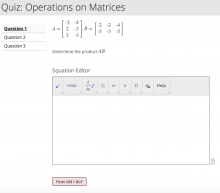The University of Waterloo has an incredibly rich set of digital science, technology, engineering, and mathematics (STEM) resources, including open educational resources, a fully online graduate program (Masters of Mathematics in Teaching), and many undergraduate courses and modules. Although some disadvantages exist, we have not found a better tool for authoring STEM materials that satisfy our online course quality guidelines. Continue reading for additional information and examples about:
- How Möbius compares to other authoring tools,
- How Möbius compares to other courseware environments, and
- Examples of Möbius's benefits in action.
How Möbius compares to other authoring tools:
The benefits of Möbius compared to other authoring tools include the following:
- It brings many courseware-related tools together within the same interface; these include text (with or without audio), embedded quiz questions, and interactive apps. This is especially useful for STEM authors who are already familiar with other Maplesoft and DigitalEd products.
- Möbius accepts LaTeX input for those who know how to use it, but also has a what-you-see-is-what-you-get (WYSIWGY) interface, including slick equation editors, for non-LaTeX users. This is particularly advantageous for individual authors and/or multi-member teams hoping to quickly build out low-fidelity prototypes to help them with planning and/or vision sharing.
- Basic audio recording and synchronization tools are available on the same page as the WYSIWYG page editor.
- Templates and/or custom style sheets can be applied across a set of resources to ensure the look and feel of your materials is one of which the author can feel proud.
- Waterloo has direct contact with the Möbius product manager and key members of the Möbius development team; we have the ability to influence the tools' key features and, to some degree, the way in which they're designed and implemented.
There are also some disadvantages when comparing Möbius to other authoring tools:
- Möbius has a rich set of features, which results in a steep learning curve to use the tool to its full potential. Now that the feature set is near complete for the first release, improving the usability of the authoring environment — especially the interactive quizzes and Math Apps — is one of the primary goals for both Waterloo and Maplesoft alike.
- Related to the authoring learning curve, Möbius's online help documentation uses lots of technical jargon that may be unfamiliar to new authors or authors unfamiliar with Maplesoft's other tools. Waterloo is working on additional instruction manuals for the authors section of this website; however, until that section of the website is complete, most authors will require at least an initial sit-down meeting or two with an experienced Möbius user before understanding how to navigate through the authoring environment and build their own suite of resources.
- Finally, there is no "desktop version" of Möbius. An Internet connection is required to access the authoring servers.
How Möbius compares to other courseware environments
In addition to the authoring-related benefits, Möbius is also proud to offer many features for students and instructional staff. As acknowledged above, authors may encounter some challenges creating resources that capitalize on Möbius's potential, but authoring difficulty is the only disadvantage. The courseware environment itself is fantastic! Here are some reasons why:
- STEM resources are output as HTML files, meaning they present all users with a consistent learning experience regardless of what device or browser they are using, and are innately more accessible for those who rely on assistive technologies to navigate through web-based content.
- Access to Maple's math engine, interactive apps, and Möbius's powerful assessment features provide students with an abundance of instant and personalized feedback. The assessment tool, in particular, takes advantage of the math engine in many innovative ways. Some of these innovations include 15 different STEM-focused question types, the ability to design questions algorithmically (meaning you can create a single question and Maple T.A. will algorithmically generate different values for the same type of questions so students sitting beside each other receive different questions and/or each student can attempt the same question multiple times), and adaptive questions that provide students with just-in-time learning supports based on their current level of understanding.
- Clear and simple navigation resulting from authors' abilities to build and present instructional content (text and/or narrated text) in the same interface as embedded quizzes and interactive apps.
Examples of Möbius's benefits in action
Authoring examples
Keep coming back to this section! Screenshots will be added shortly after the inaugural version of Möbius is officially released.
Courseware examples
Example: Algorithmically-designed free response question

- Users practise matrix multiplication; they are tested on their abilities to determine the dimensions of a resulting matrix in addition to the values themselves.
- When users click "how did I do?", they see customized feedback.
- Users can click "try again" once reviewing the feedback to generate a new set of values and try the question again.
- Although not evident in this example, the Maple math engine is calculating the correctness of students' responses on the back end. For example, if fractions were used rather than decimal values, equivalencies would be recognized (e.g., 1/2 = 0.5 = .500 = 50%, etc.).
Example: Adaptive question

- If users get a quiz question incorrect, they are presented with a simpler question that breaks the original question down into smaller steps.
Keep coming back to this section! We'll add more links, screenshots, and examples as our suite of Waterloo-built Möbius assets continues to grow over time.




